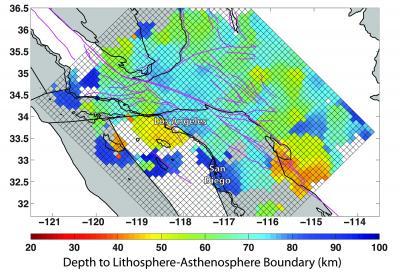You can thank the stretching of continents and the oceans that filled those newly created basins for the Earth we know today. Rifting is one of the fundamental geological forces that have shaped our planet. But rifting involves areas deep below the Earth's surface so scientists have been unable to understand fully how it occurs.
What is known is that with rifting, the center of the action lies in the lithosphere, which makes up the tectonic plates and includes the crust and part of the upper mantle. A paper in Science now provides us with the highest-resolution picture of the bottom of the lithosphere in southern California, one of the most complex, captivating geologic regions in the world. The lithosphere's thickness differs markedly throughout the region, yielding new insights into how rifting shaped the southern California terrain.
The team measured the boundary separating the lithosphere from the more ductile layer just below it known as the asthenosphere in a 400-by-300-mile grid, an area that includes Santa Barbara, Los Angeles, San Diego and the Salton Trough. The lithosphere's thickness varies surprisingly from less than 25 miles to nearly 60 miles, the researchers write.
"We see these really dramatic changes in lithosphere thickness, and these occur over very small horizontal distances," said Karen Fischer, professor of geological sciences at Brown and a paper author. "That means that the deep part of the lithosphere, the mantle part, has to be strong enough to maintain relatively steep sides. This approach provides a new way to put observational constraints on how strong the rocks are at these depths."


Researchers have now measured the lithosphere's thickness in southern California. It varies widely, from less than 25 miles to nearly 60 miles. Credit: Fischer Lab, Brown University
Specifically, the researchers found two areas of particular interest. One is the Western Transverse Range Block. The plate lies below Santa Barbara, yet some 18 million years ago, it was located some 125 miles to the south and hugged the coastline. At some point, this plate swung clockwise, rotating more than 90 degrees and journeyed northward, like a mobile, swinging door. Interestingly, the lithosphere remained intact, while the area left behind the swinging plate, called the Inner Continental Borderland and which lies off the coast of Los Angeles, was stretched, the Brown geophysicists believe. Indeed, the lithosphere is nearly 30 percent thinner in the area left behind than the range block.
"The fact that the Western Tranverse Range Block retained its lithosphere along its journey tells us the mantle-lithosphere (of the block) must be very strong," said Vedran Lekic, a postdoctoral researcher at Brown University and first author on the paper.
Another interesting feature noted by the researchers is the Salton Trough, which encompasses the Salton Sea and the city of Palm Springs, and "is a classic example of rifting," according to Fischer. Some 6 million years ago, the continental plate at this location was stretched, but the question remains whether it simply thinned or whether it actually broke apart, creating new lithosphere in between. In the paper, the researchers confirm that the lithosphere is thin, but "we can't tell which of these scenarios happened," Fischer said. However, the thickness of the mantle part of the lithosphere and the fact that deformation at the surface runs all the way to the base of the lithosphere in roughly the same geographical location are new constraints against which modelers can test their predictions, she added.
The team made use of permanent seismic recording stations set up by the Southern California Seismic Network and other networks, as well as seismometers from the EarthScope USarray Transportable Array, a grid of National Science Foundation-funded stations that is gathering earthquake information as it moves west to east across the nation. To measure the lithosphere's depth, the authors looked at how waves generated by earthquakes — called S waves and P waves — convert from type S to type P across the boundary between the lithosphere and the asthenosphere.
The team will compare its results with those of another famous rift system in East Africa, from a study at the University of Bristol led by Kate Rychert, who earned her doctorate at Brown in 2007.




Comments